
The Haunted Mansion is a dark ride attraction located at Disneyland Park, Magic Kingdom, and Tokyo Disneyland. The attraction, although differing slightly in every location, places riders inside a haunted manor resided in by "999 happy haunts."
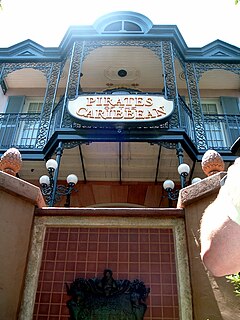
Pirates of the Caribbean is a dark ride at Disneyland, Walt Disney World's Magic Kingdom, Tokyo Disneyland, Disneyland Park at Disneyland Paris, and Shanghai Disneyland.

Disney's Grand Californian Hotel & Spa is a hotel located at the Disneyland Resort in Anaheim, California. The hotel was constructed as part of a major expansion of the Disneyland Resort in 2001. It was built by The Walt Disney Company and has been operated by The Walt Disney Company since its inception. This luxury hotel is designed to celebrate the early 20th Century Arts and Crafts era, showcasing the once-dominant architectural style of California. It also features a Disney Vacation Club wing that opened in September 2009. The hotel has a private entrance to Disney California Adventure Park. In 2017, Disney completely remodeled the rooms, along with the lobby.

Club 33 is a private dining club located within the Disneyland Park. Opened in 1967 by Walt Disney, the club was modeled after numerous executive lounges created by pavilion sponsors in the 1964 World's Fair. The club replaced The Disney Room of the Red Wagon Inn at Central Plaza.

Cinderella Castle is Cinderella's home fairy tale castle and the icon at the center of two Disney theme parks: the Magic Kingdom at the Walt Disney World Resort, and Tokyo Disneyland at the Tokyo Disney Resort. Both serve as the flagship attraction for their respective theme parks. Along with Sleeping Beauty Castle, the Castle is a main symbol of The Walt Disney Company.

The World of Disney is the flagship chain of specialty retail stores owned and operated by the merchandise division of Disney Parks, Experiences and Products, a subsidiary of The Walt Disney Company. Currently, there are four locations that sell Disney products.

Sleeping Beauty Castle is a fairy tale castle at the center of Disneyland and formerly at Hong Kong Disneyland. It is based on the late-19th century Neuschwanstein Castle in Bavaria, Germany. It appeared in the Walt Disney Pictures title card, and, along with Cinderella Castle, is an iconic symbol of The Walt Disney Company. The version at Disneyland is the only Disney castle whose construction was overseen by Walt Disney.
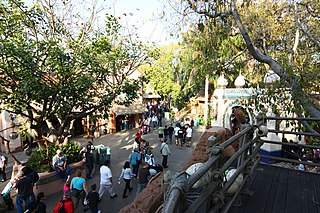
Adventureland is one of the "themed lands" at the many Disneyland-style theme parks run by the Walt Disney Company around the world. It is themed to resemble the remote jungles in Africa, Asia, South America, the South Pacific and the Caribbean. "To create a land that would make this dream reality", said Walt Disney, "We pictured ourselves far from civilization, in the remote jungles of Asia and Africa."

New Orleans Square is a themed land found at Disneyland Park in Anaheim, California. Based on 19th-century New Orleans, Louisiana, the roughly three-acre area was the first land to be added to Disneyland after the park's opening, at a cost of $18 million. It is exclusive to Disneyland, although a similarly themed area can be found within Adventureland at Tokyo Disneyland.

Disney's Old Key West Resort is a Disney Vacation Club resort at the Walt Disney World Resort. It opened on December 20, 1991 and was formerly known as Disney's Vacation Club Resort until January 1996 when it was renamed. It was the first Disney Vacation Club Timeshare Resort, and has the largest rooms of any of the fifteen Disney Vacation Club Resorts. The accommodations include kitchen facilities and a laundry room. The rooms are designed in a Key West theme. Rooms are also available year-round for rental by non-members as Disney Vacation Club retains ownership of a majority of the resort.

Shades of Green is a resort owned by the United States Department of Defense (DOD) in the city of Bay Lake, Florida, near Orlando, Florida on Walt Disney World property. It is one of five Armed Forces Recreation Centers (AFRC) resorts and a part of the military's Morale, Welfare, and Recreation program (MWR). The resort, which was expanded between 2004-2006, is self-supporting and operates from non-appropriated funds and all profits are put back into the resort.
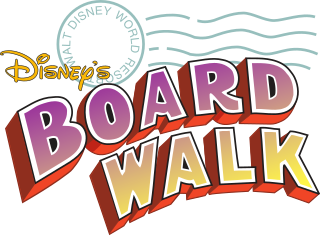
Disney's BoardWalk Resort is a AAA Four-Diamond Award–winning hotel and entertainment complex at the Walt Disney World resort, in Bay Lake, Florida, near Orlando, Florida. First opened in 1996, the BoardWalk Resort lies in the Epcot Resort Area, alongside Crescent Lake, and is situated between Epcot and Disney's Hollywood Studios. The resort is owned and operated by Disney Parks, Experiences and Products. The inn and the villas share a common lobby with the rest of the resort. The Inn, Atlantic Dance Hall, and other features of the boardwalk were designed by Robert A.M. Stern Architects.
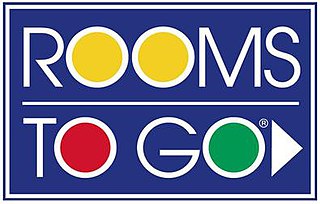
Rooms To Go is an American furniture store chain. Based in Seffner, Florida, the company operates 226 stores in Alabama, Florida, Georgia, Louisiana, Mississippi, North Carolina, South Carolina, Tennessee, Texas, Virginia, and Puerto Rico. The company was founded in September 1990 by Jeffrey and Morty Seaman, when they sold Seaman Furniture Company. According to Furniture Today, Rooms To Go is the 3rd largest furniture retailer in the US.

Innoventions was a two-story exhibit in Tomorrowland at Disneyland in Anaheim, California. It opened on July 3, 1998 as part of the New Tomorrowland, focusing on near-futuristic technologies. The attraction operated for nearly 17 years, closing on March 31, 2015. From 2013 until its closure, its focus mainly shifted to character meet-and-greets featuring superheroes from the Marvel Cinematic Universe. It occupied the Carousel Theater, a round two-story building in which the outer half of the first floor rotates. A similar attraction of the same name existed in Epcot at the Walt Disney World Resort until 2019.

Disneyland Park, originally Disneyland, is the first of two theme parks built at the Disneyland Resort in Anaheim, California, opened on July 17, 1955. It is the only theme park designed and built to completion under the direct supervision of Walt Disney. It was originally the only attraction on the property; its official name was changed to Disneyland Park to distinguish it from the expanding complex in the 1990s. It was the first Disney theme park.
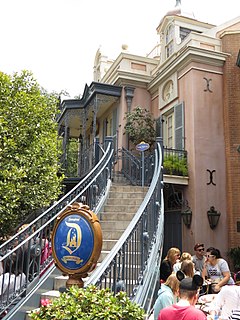
The Disneyland Dream Suite was a 2,200-square-foot (200 m2) luxury apartment located in the New Orleans Square area of Disneyland Park at the Disneyland Resort. It was created as part of the "Year of a Million Dreams" promotion that ran from October 1, 2006, through December 31, 2008, and closed in 2014.

Main Street, U.S.A. is the first "themed land" inside the main entrance of the many 'Disneyland'-style parks operated or licensed by The Walt Disney Company around the world.
Walt's – An American Restaurant is a dinner place located on Main Street, U.S.A. at Disneyland Paris, themed to Walt Disney, the creator of the Walt Disney Company. It is known as one of the main restaurants of the resort, and specialises in table services.

Star Wars: Galaxy's Edge is a themed area inspired by the Star Wars franchise, located within Disneyland Park at the Disneyland Resort in Anaheim, California, and Disney's Hollywood Studios at the Walt Disney World Resort in Orlando, Florida. The area encompasses 14 acres (5.7 ha) at each park. Galaxy's Edge is set within the village of Black Spire Outpost, on the remote frontier planet of Batuu, and features attractions, shops, restaurants, and entertainment offerings.


















